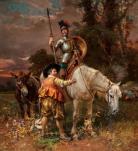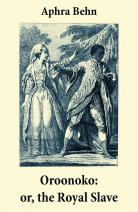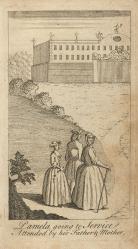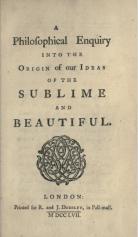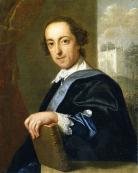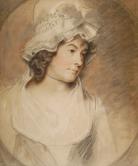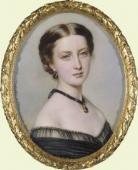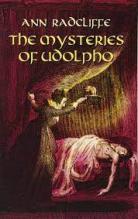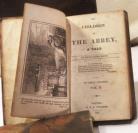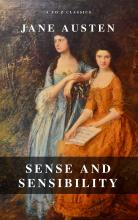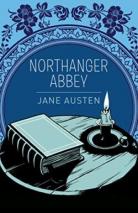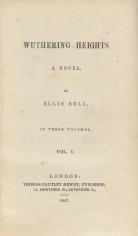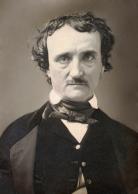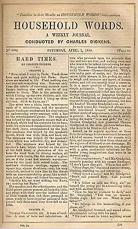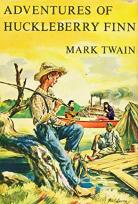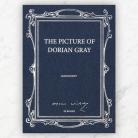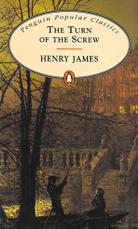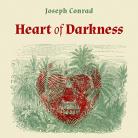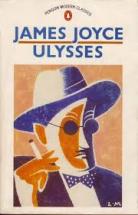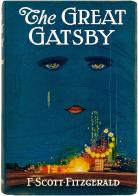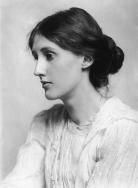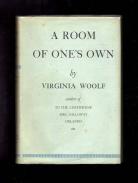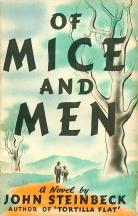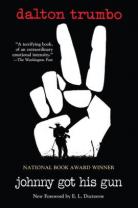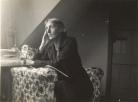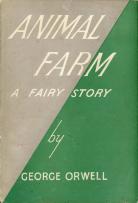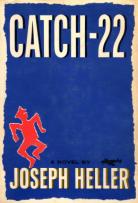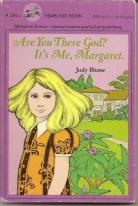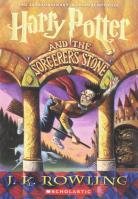History & Development of the Novel
Created by Bettina Pedersen on Sat, 03/27/2021 - 03:36
Part of Group:
This is an ongoing collaborative and individual assignment in COVE Editions built upon the work we began in our first class discussions of the question, “What is a novel?” and in your subsequent exploratory research to suss out a more developed and complex understanding of what the novel is as a literary art form. Our timeline will begin in the mid- to later 1700s with Barford Abbey and all of the cultural context that informs her abbey fiction. We will extend our consideration of the form and development of the novel into the early mid- 1900s by the time we conclude our course.
Timeline
Chronological table
| Date | Event | Created by | Associated Places | |
|---|---|---|---|---|
| 1605 to 1615 |
"Don Quixote" by Miguel de Cervantes"Don Quixote," written by Miguel de Cervantes, was published in two parts, the first being in 1605 and the second in 1615 ("Don Quixote" Par.1). It is regarded as being a "parody of chivalric romances...[and]...a prototype of the modern novel" ("Don Quixote" Par.1). Despite this, according to Bruce W. Wardropper in" 'Don Quixote': Story or History?", Cervantes himself never referred to his work as being a novel or a novella instead, "he prefers to call his book an 'historia,'... [which means that then]... [w]e have to deal...with a story masquerading as history" (Wardropper, pp.1). Cervantes's decision to categorize his work as a history suggests that the novel as an artform is innately tied to philosophical questionings of objectivity. Elaborating further on the novel as an artform, Wardropper states that it is the genre's "... awareness of the ill-defined frontier between history and story, between truth and lie, between reality and fiction is what categorizes the novel as [being]...the most self-conscious...[and]... introverted of literary genres" (Wardropper, pp.5). Regardless, Miguel de Cervantes's "Don Quixote" remains a widely influential piece of literature even after the 17th century.
Wardropper, Bruce W. "'Don Quixote': Story or History?" Modern Philology, vol. 63, no. 1, 1965, pp. 1–11. JSTOR, www.jstor.org/stable/436890. Accessed 2 June 2021. Britannica, The Editors of Encyclopaedia. "Don Quixote." Encyclopedia Britannica, 28 Aug. 2020, https://www.britannica.com/topic/Don-Quixote-novel. Accessed 1 June 2021. |
Carmen Flores-Lopez | ||
| circa. 1688 |
Aphra Behn's Oroonoko or, the Royal Slave. A true history.Aphra Behn's Oroonoko is one of the earliest examples of the novel genre. Originally published in 1688, this novel employs the first person narritve voice from a female perspective while also working to examine some of the most controversial issues of the 17th century. Through Behn's account of the realities of life in the English colonies in North America, she exposes the horrors of the transatlantic slave trade. This novel also is credited with the begining of the "noble savage" trope. While in the present day this theme is now understood to be a deeply racist view point, in the later part of the 18th centry it was recognized as being a literary concept which lent to for the abolition of slavery. “Aphra Behn's Oroonoko, 1688.” The British Library, The British Library, 5 Dec. 2017, www.bl.uk/collection-items/aphra-behns-oroonoko-1688 |
Katie Jackson | ||
| 28 Oct 1726 |
Gulliver's Travels by Jonathan SwiftText. |
Matt Burch | ||
| 1740 |
Samuel Richardson & The Epistolary NovelSamuel Richardson (1689-1761) is an English author known for three major epistolary novels: Pamela, or Virtue Rewarded (1740), Clarissa, or The History of a Young Lady (1748), and The History of Sir Grandison (1753) all of which predate the publication of Susannah Minifie Gunning's epistolary novel, Barford Abbey in 1678. The long epistolary novels of Richardson would have been familiar to Gunning, and may have been one of the cultural factors contributing to the much shorter length of her Barford Abbey (Doody & Milberger, "Introduction," 14). Richardson Pamela "follows the travails of a young, virtuous maidservant as she seeks to fend off and then reform her rakish employer. Astonishingly for the time, Richardson’s epistolary novel highlighted the inner life and moral principles of a protagonist from a modest background" ("Samuel Richardson"). His novel Clarissa also portrays a chaste and virtuous lady being relentlessly pursued by the rake, Richard Lovelace, but his Sir Grandison, relates a story "in which male moral virtue was lauded" ("Samuel Richardson"). Given the prevalence of good men in Gunning's Barford Abbey, she may have been working to combine representations of both virtuous women and virtuous men in her epistolary novel with Richardson's examples in mind.
Doody, Margaret, and Kurt Edward Milberger. “Introduction.” Barford Abbey, Broadview, 2021, pp. 9–21. “Samuel Richardson.” Discovering Literature: Restoration & 18th Century, British Library, 27 Mar. 2021, 1:15, www.bl.uk/people/samuel-richardson. |
Bettina Pedersen | ||
| 1740 |
"Pamela, or Virtue Rewarded" by Samuel RichardsonPamela, or Virtue Rewarded is the first novel published by Samuel Richardson in 1740 (Doody). The story centers around the young protagonist Pamela who becomes the servant of a Mr. B, her preivous lady's son after her death. Mr B. becomes infatuated with Pamela and attempts to seduce her multiple times despite her resistance. Pamela tries to escape multiple times but is unsucessful. Eventually Mr. B sexually assaults Pamela and after proposes to her afterwards. While she initially refuses Pamela realizes that the is in love with Mr. B and accepts despite the class difference between them.
Pamela received its fair share of critisim upon its publication with many critising its explicit sexual themes (Doody). However, despite this critisim Pamela would be immensly popular becoming "perhaps the first 'best-seller'" (Doody). Through Pamela, Richardson would greatly popularize the epistolary genre and would go on to write two more epistorlary novels. In addition, this novel was published far before Susannag Gunning's epistolary novel Barford Abbey. As such, Pamela would have influenced Gunning's style especially with the central conflicts of class difference and marriage playing a big role in both works. (188 words)
Doody, Margaret. “An Introduction to Pamela, or Virtue Rewarded.” The British Library, The British Library, 18 May 2018, www.bl.uk/restoration-18th-century-literature/articles/an-introduction-t.... |
Christian Wong | ||
| 1747 to 1748 |
"Clarissa" by Samuel RichardsonSamuel Richardson (1689-1761) was an English novelist that was apprenticed to a printer and later on opened his own printing shop in London. Richardson became known as a gifted epistolary writer and wrote a volume of model letters that appeared as Familiar Letters (1741). His continued work resulted in the publication of the novel Pamela; or Virtue Rewarded (2 vol., 1740), Clarissa; or the History of a Young Lady (7 vol., 1747–48), and History of Sir Charles Grandison (7 vol., 1753–54). Clarissa was known as a huge success when it first appeared in 1747, and it was translated into French and German. In the book Passion and Virtue: Essays on the Novels of Samuel Richardson by David Blewett, he describes Richardson's Clarissa as a portrayal of "... two vigorously competing world-views of his time, Hobbism, which percieves a materialistic universe based on restlessness, power, corruption, and self-interest, and Christian Platonism, which assumes the universe to be spiritually informed" (93). In addition, Gordon Fulton mentions in his book Styles of Meaning and Meanings of Style in Richardon's Clarrisa, how the novel encourages people to critique the existing ideologies, the dynamic of courtship, and the concept of seduction. Richardon also intended for his work to help readers decide on how they were going to act and/or think in different situations.
Fulton, Gordon. Styles of Meaning and Meanings of Style in Richardson's Clarissa, McGill-Queen's University Press, 1999. ProQuest Ebook Central, https://ebookcentral-proquest-com.pointloma.idm.oclc.org/lib/pointloma-e.... Passion and Virtue : Essays on the Novels of Samuel Richardson, edited by David Blewett, University of Toronto Press, 2001. ProQuest Ebook Central, https://ebookcentral-proquest-com.pointloma.idm.oclc.org/lib/pointloma-e.... “Richardson, Samuel.” Funk & Wagnalls New World Encyclopedia, Jan. 2018, p. 1; EBSCOhost, search.ebscohost.com/login.aspx?direct=true&db=funk&AN=ri045700&site=ehost-live.
|
Jasmin Segarra | ||
| 1757 |
Edmund Burke: The Sublime and BeautifulEdmund Burke (1729-1797) was an Irish statesman and philosopher known for his influential treatise, A Philosophical Enquiry into the Origin of Our Ideas of the Sublime and Beautiful (1757). In the work, Burke discusses the grotesque, along with the duality of horror and sublime, all associated with the Romantic and Gothic movements. Burke proposes beauty stimulates love: "I call beauty a social quality; for where women and men, and not only they, but when other animals give us a sense of joy and pleasure in beholding them (and there are many that do so), they inspire us with sentiments of tenderness and affection towards their persons;" (Burke 115). In the same vein that beauty inspires tenderness, the sublime brings tention through horror: "Whatever therefore is terrible, with regard to sight, is sublime too, whether this cause of terror be endued with greatness of dimensions or not; for it is impossible to look on anything as trifling, or contemptible, that may be dangerous" (Burke 131). The sublime is triggered by extremes, which Burke mobilizes into stressing the importance of perceiving possible threats. As Doody and Milberger point out in their "Indroduction," these threats can be "hidden emotional and social causes" which "bring about unanticipated and even undersired effects" (17). These undesired effects are a direct cause of the sublime, which inform the way characters behave and function in their given society. Often, characters like Sir James Powis and Lord Darcey are insistent on power and control, an observable response to these "unanticipated and even undesired effects" (Doody and Milberger 17). What power grabs will we see in Northanger Abbey among characters who struggle to balance the extremes of horror and pleasure? Perhaps we can see the novel function as a study or observation of human response to the nature of duality. Burke, Edmund. A Philosophical Enquiry into the Origin of Our Ideas of the Sublime and Beautiful. Printed for R. and J. Dodsley in Pall-Mall, 1757. Doody, Margaret, and Kurt Edward Milberger. “Introduction.” Barford Abbey, Broadview, 2021, pp. 9–21. |
lindsey | ||
| 1764 |
Horace Walpole: Inventing the Gothic NovelHorace Walpole (1717-1797) was the author of the first Gothic novel, The Castle of Otranto (1764) and is revered for his influence on the Gothic novel genre. Set in Renaissance Italy the novel focuses on, “Walpole’s story of the tyrant prince Manfred, usurper of Otranto, who tries in vain to forestall a mysterious prophecy about the reversion of the kingdom to its real owner by securing heirs to his throne” (Napier) While Susannah Minifie Gunning’s novel Barford Abbey (1768) was published a few years later, it’s more serious tone does not reflect the implausibility within the genre that Walpole establishes with The Castle of Otranto. Described as “Rife with supernatural events, incestuous undertones, and medieval imagery” (Schoenberg and Davidson), Walpole’s novel is different in tone and structure than Susannah Minifie Gunning’s Barford Abbey (1768) which was a Gothic epistolary novel without the paranormal mystery or mystical themes. Gunning’s style exemplifies the variety in tone that the Gothic genre encompasses within the format of a novel.
Napier, Elizabeth R. "Horace Walpole." British Novelists, 1660-1800, edited by Martin C. Battestin, Gale, 1985. Dictionary of Literary Biography Vol. 39. Gale Literature Resource Center, link.gale.com/apps/doc/H1200003803/LitRC?u=sand82993&sid=LitRC&xid=3443763d. Accessed 3 Apr. 2021. "The Castle of Otranto." Literature Criticism from 1400 to 1800, edited by Thomas J. Schoenberg and Ian Davidson, vol. 152, Gale, 2008. Gale Literature Resource Center, link.gale.com/apps/doc/H1410002110/LitRC?u=sand82993&sid=LitRC&xid=3a51cc4c. Accessed 3 Apr. 2021. |
Anthony Calvez | ||
| The start of the month Summer 1768 to The start of the month Summer 1768 |
Susannah Minifie Gunning's Barford AbbeyBarford Abbey, written by Susannah Minifie Gunning and published in 1768, is an abbey fiction novel written in the epistolary style. This style of writing is presented in a series of letters, constructing a story out of letter exchanges between characters to create an atmosphere of intimacy and a quality of authenticity (“Letters, letter writing, and epistolary novels''). It was published in the midst of the growing popularity of letter-writing for efficient communication, and when publishing personal letters for the public to read became common as well (“Letters, letter writing, and epistolary novels''). This style of fiction had been heavily defended by other writers like Samuel Johnson, and became a recognized art form in its ability to capture life (Doody & Milberger, “Appendix A3,” 215). The story of Barford Abbey itself is a major contributor to the start of abbey fiction and gothic literature, with the physical abbeys of Britain being known for their tumultuous religious and royal history. The physical imagery of abbeys being used as symbols to portray change, conflict, and commentary on status and societal hopes and fears made one the perfect place for the protagonist of Barford Abbey, Fanny Warley, to unexpectedly stay and get caught up in the complicated notions of wealth and aristocracy (Doody & Milberger, “Introduction,” 14). Curran, Louise. “Letters, Letter Writing and Epistolary Novels.” The British Library, The British Library, 18 May 2018, www.bl.uk/restoration-18th-century-literature/articles/letters-letter-writing-and-epistolary-novels. Gunning, Susannah Minifie, et al. “Appendix A: ‘Writing to the Moment’: The Epistolary Style.” Barford Abbey. Broadview Press, 2020. Pg. 215 Gunning, Susannah Minifie, et al. “Introduction.” Barford Abbey. Broadview Press, 2020. Pg. 14 |
Amarí Burgos-Santoyo | ||
| 1788 |
Charlotte Turner Smith and "Ethelinde"Charlotte Turner Smith (1749-1806) is a significant English author and poet, and considered an influential member of the Romantic movement. Her work was subject of great praise from poet Sir Walter Scott. Notable works include her Elegiac Sonnets and other Essays (1784), Emmeline, the Orphan of the Castle (1788), Ethelinde, or the Recluse of the Lake (1789), and The Old Manor House (1793). The use of architecture such as castles and abbeys reflects the gothic influence in Smith's writing. Etheline features an orphaned female protagonist in an abbey, similar to Barford Abbey by Susannah Minifrie Gunning, published twenty years before Etheline. Charlotte Smith's novel was still an early example of the genre and contributed a bolder stance on the abbey's significance as a social symbol in England. Following the death of Etheline's parents, she is relocated to Grasmere Abbey to live with Mr. Maltravers. Lady Newenden, cousin of Etheline, directly berates Grasmere Abbey, calling it a "nunnery" where people go to die (Smith 281). The orphaned female protagonist trope is rather curious. It is unclear why Smith models Etheline so closely after Gunning's Fanny Warley, but abandonment seems to be a quality shared by the protagonists and abbeys themselves. Keane, Angela. Revolutionary Women Writers : Charlotte Smith and Helen Maria Williams, Northcote House Pub, 2013. ProQuest Ebook Central, https://ebookcentral-proquest-com.pointloma.idm.oclc.org/lib/pointloma-e.... Smith, Charlotte Turner. “From Charlotte Smith, ‘Ethelinde’ (London: T Cadell, 1789.’” Barford Abbey, by Susannah Minifrie Gunning et al., Broadview Press, 2020, pp. 267–281. |
Shane Hoyle | ||
| 1789 |
"Ethelinde" by Charlotte SmithThe novel Ethelinde (1789), by Charlotte Smith is one of the first novels to be considered to include elements of the Gothic genre. Though Smith was known throughout her career for poetry, she began writing novels later in life in order to make money for herself and her family. She, much like Susannah Gunning, had much strife with her family and economic stability, which served as inspiration for her writing of Ethelinde. An article by Lisa Ottum about Smith’s work suggests that the setting in which she places her novels allude to a gothic style: “[i]n her fiction, Smith invests topography with a sense of depth that challenges other Romantic representations of nature, especially those that celebrate the panoramic view and its putative comprehensiveness,” (250). Smith centers Ethelinde in an abbey much like Austen and Gunning. In her illustration of the abbey as setting, she insinuates a mysterious melancholy that contributes to a romantically gothic style. This novel exemplifies the genre of abbey fiction, while also illustrating the overlap of gothic genre and the romantic period. Ottum, Lisa. “‘Shallow’ Estates and the ‘Deep’ Wild: The Landscapes of Charlotte Smith's Fiction.” Tulsa Studies in Women's Literature, vol. 34, no. 2, 2015, pp. 249–272. JSTOR, www.jstor.org/stable/44784589. Accessed 4 Apr. 2021. |
Isabella Dempsey | ||
| 1791 |
Ann Radcliffe: Suspense in the GothicAnn Radcliffe (1764-1823), a prolific English author well-known for her novel The Mysteries of Udolpho (1794), can be described as "one of the founders of Gothic fiction" (Townshend). Among Radcliffe's other famous works is The Romance of the Forest (1791). Despite its publication after Susannah Minifie Gunning's Barford Abbey (1768), this novel possesses key themes that can be connected to not only the history and development of the gothic genre and novel but parts of Barford Abbey's plot. Radcliffe's writing style was notable for its blending of Romantic literature's traditional sensibility with terror and suspense. We get a distinct emphasis on mystery in The Romance of the Forest excerpts included in our Northanger Abbey (1817) Appendix C. The following line reveals the importance of mysticism within her character's actions and curiosity: "'A mystery seems to hang over these chambers,' said she, 'which it is perhaps my lot to develop; I will, at least, see to what that door leads" (Radcliffe 137). These sentences not only contribute to the specific setting of this novel about France in the 17th-century (The Editors of Encyclopaedia Britannica) but connect back to the sense of mystery that permeates the plot of Barford Abbey. One can therefore make the assumption that most gothic novels were formed around the idea of the unknown. Radcliffe specifically focused on "an omnipresent sense of mystery and obscurity over the certainties of fast-paced action, and by mere hints and suggestions of ghostly activity over fully realised manifestations of the supernatural" (Townshend). While there aren't any ghosts in her novel, Gunning similarly employs suspense involving Fanny's "drowning," which results in a big misunderstanding rather than actual death. Both of these novels end similarly as well, with discoveries of advantageous family connections and marriage. On the whole, Radcliffe's The Romance of the Forest and various other writings impacted the genre of gothic fiction through their particular style and her impact on other authors, such as Jane Austen (as we have read)a, who would emerge on the scene to follow in Radcliffe's footsteps. Radcliffe, Ann. The Romance of the Forest. Claxton, Remsen & Haffelfinger, 1872. The Editors of Encyclopaedia Britannica. “Ann Radcliffe.” Encyclopædia Britannica, Encyclopædia Britannica, Inc., 10 Mar. 2021, www.britannica.com/biography/Ann-Radcliffe-English-author. Townshend, Dale. “An Introduction to Ann Radcliffe.” The British Library, The British Library, 22 Sept. 2014, www.bl.uk/romantics-and-victorians/articles/an-introduction-to-ann-radcl.... |
Meghan Coley | ||
| 8 May 1794 |
The Mysteries of Udolpho, Ann RadcliffeThe Mysteries of Udolpho by Ann Radcliffe appeared in May of 1794. This work consists of four volumes with the last and most popular being The Mysteries of Udolpho. Set in 1584 in the south of France and northern Italy, the novel depcits the story of a young girl named Emily St. Aubert, complete with gloomy castle setting, the death of her parents, and supernatural terrors. Often cited as the archetypal Gothic novel "The Mysteries of Udolpho appears prominently in Jane Austin's 1817 novel Northanger Abbey [in which] an impressionable young woman comes to see friends and acquaintances as Gothic villains and victims, with amusing results" (Mambrol, "Gothic Novels and Novelists"). Mambrol, Nasrullah. “Gothic Novels and Novelists.” Literary Theory and Criticism, 18 Mar. 2019, literariness.org/2019/03/11/gothic-novels-and-novelists/. |
Katie Jackson | ||
| 1796 |
Regina Maria Roche: The Children of the AbbeyRegina Maria Roche (1764-1845) is the author of a multitude of novels under the umbrella of Gothic literature, and is arguably most famous for The Children of the Abbey (1796). Roche’s writing style and content were so similar to that of Ann Radcliff’s, that she was known as “Ireland’s Anne Radcliff'' (Power). As contemporaries, both women drew heavily off the ground work that Barford Abbey (1768) set in the Gothic genre. With The Children of the Abbey being published more than 25 years after Barford Abbey, it contains what we now would expect from a sentimental Gothic novel from the 18th century: “gothic places, old mansions, a haunted abbey, [and] a twisted plot” (Harral). Even though some might believe that Roche’s career was overshadowed by that of Radcliff’s, it’s undeniable that Roche found great success in this particular book: “[the novel] is Radcliffian Gothic domesticated, entertaining readers with the charms of sentimental indulgence and escapist fantasy plut the occasional frisson of terror, all set reassuringly in the familiar context of late eighteenth-century polite society” (Howells). The Children of the Abbey seemed to have contained all the right ingredients for a commercially successful book in that time era. It possessed all of the trademark items of a good Gothic novel, adopted the traditional characteristics of a sentimental novel, and included a bit of fantastical imagination in a setting that would be comfortable and familiar to the intended audience. Harral, Ashhesz, and Ashley Harral. “Regina Maria Roche – ‘The Children of the Abbey.’” Go to the Cover Page of From Cradle to Grave, Backwater to Empire, Dr. Erin Webster Garrett, 8 May 2013, c18digiemp.pressbooks.com/chapter/regina-maria-roche-the-children-of-the-abbey/#return-footnote-65-3. Howells, Coral Ann. Love, Mystery, and Misery: Feeling in Gothic Fiction. London: The Athlone Press University of London, 1978. 82-100. Print. Power, Albert. “Regina Maria Roche (1764-1845).” The Green Book: Writings on Irish Gothic, Supernatural and Fantastic Literature, no. 11, 2018, pp. 35–41. JSTOR, www.jstor.org/stable/48536178. Accessed 4 Apr. 2021. |
Brennan Ernst | ||
| Autumn 1811 |
"Sense and Sensibility" by Jane AustenSense and Sensibility by Jane Austen (1775-1817) was published in 1811 anonymously under the name "By A Lady". In the beginning of Austen's career it took her almost 15 years to find a publisher which is during the time she wrote Sense and Sensibility. Sense and Sensibility tells a story revolving around the Dashwood sisters and their experiences of societies constructed rules of etiquette , manners, and proper passion. In Claudia Johnson's essay "Sense and Sensibility: Opinions Too Common and Too Dangerous" she argues that Sense and Sensibility is, "... dark and disenchanted novel exposes how those sacred and supposedly benevolent institutions of order - property, marriage, and family - actually enforce avarice, shiftlessness, and oppressive mediocrity" (par. 1). Johnson continues by mentioning the importance of how Austen highlighted how the absence of male protectors thus resulting in the marginalization of women and concludes by calling this novel Austen's most socially progressive work (par. 6). Austen's work influenced and used the novel to push against and expose social constructs in a way that used everyday life to demonstrate the difficulties of obding by the rules enforced on women during the time. “Austen, Jane.” Funk & Wagnalls New World Encyclopedia, Jan. 2018, p. 1; EBSCOhost, search.ebscohost.com.pointloma.idm.oclc.org/login.aspx?direct=true&db=funk&AN=au176300&site=ehost-live.
Johnson, Claudia L. "Sense and Sensibility: Opinions Too Common and Too Dangerous." Nineteenth-Century Literature Criticism, edited by Lawrence J. Trudeau, vol. 271, Gale, 2013. Gale Literature Resource Center, link.gale.com/apps/doc/H1420114147/LitRC?u=sand82993&sid=bookmark-LitRC&xid=ea12e780. Accessed 1 June 2021. Originally published in Jane Austen, U of Chicago P, 1988, pp. 49-72.
|
Jasmin Segarra | ||
| Winter 1817 |
Northanger AbbeyNorthanger Abbey written by Jane Austen was published in the December of 1817 after she passed away in July. Before Northanger Abbey was “Northanger Abbey,” Austen started writing this piece as “Susan” around the years 1798 and 1799. Unfortunately, she sold her story to a publisher, Crosby, who advertised it in their Flowers of Literature magazine however, it was never published. After confronting Crosby about the “mishap,” she wanted to take Susan to another publisher but had to purchase her manuscript back from Crosby in order to avoid Crosby taking proceedings to stop the sale. Austen would have to have spent ten pounds to purchase the manuscript back (which would be around $306.20 today), and decided to work on some of her other works such as “Elinor and Marianne” (soon to be known as Sense & Sensibility published in 1812). After regaining the manuscript in 1816 and published another novel titled Emma, she renamed Susan as now, Catherine. However, even after renaming this piece, she still let the manuscript sit to the side as she continued to publish other novels until she passed in 1817. In fact, her brother, Henry Austen, was the publisher and altered the name of the novel to Northanger Abbey. He paired this piece with another one of Austen's novels, Persuasion, and included Henry's "Biographical Notice" in the preface of the novel. Northanger Abbey is a coming-of-age story of a young woman named Catherine Morland. Coming from a rural family, Catherine experiences life in the gentry class as she was invited to stay with the Allen family in Bath. There Catherine learns about the social society and the dynamic between young women and prospective young men as well as tries to unravel some unsettling mysteries that Catherine comes across during her time there. Overall, Catherine is searching for a better understanding of herself and the world around her. Austen, Jane, and Claire Grogan. “The Novel's History.” Northanger Abbey, Broadview Press, 2004, pp. 8–17. |
Camryn Ostrander | ||
| 1818 |
Mary Shelley's: FrankensteinMary Shelley (1797-1851) was a famous novelist whose best-known work is Frankenstein; or, The Modern Prometheus (1818), although she published other books including The Last Man (1826) and Lodore (1835) (“Mary Shelley”). Frankenstein interestingly opens and closes in the epistolary format just like the novel Barford Abbey, although the main bulk of the novel is written in narrative form (“Frankenstein, An Introduction To”). The protagonist of the novel, Victor Frankenstein, creates a creature from the parts of corpses but quickly abandons it out of fear once the creature is brought to life. The creature faces constant rejection from society and eventually goes after Frankenstein for bringing him alone into a cold world. This novel is extremely important as it was one of the first novels to merge the gothic and romantic genres (Sundaram). The combination of the horror imagery with the romantic emphasis on emotions caused Frankenstein to become a classic which is still widely taught in many classrooms across America today.
“Frankenstein, An Introduction To.” Nineteenth-Century Literature Criticism, vol. 170, 2006. “Mary Shelley.” Biography.com, A&E Networks Television, 28 Feb. 2020, www.biography.com/writer/mary-shelley. Sundaram, Mark, director. Sublime: The Aesthetics & Origins of Romanticism. YouTube, YouTube, 2 Feb. 2016, www.youtube.com/watch?v=au-z2jVaTNk&feature=youtu.be. |
Christian Wong | ||
| 1818 to 1849 |
Emily Bronte's Wuthering Heights and It's Possible Connections to Jane Austen's Northanger AbbeyWuthering Heights by Emily Bronte was published in 1847, a mere year before its author would lose her life to pulmonary tuberculosis (Newman, "Emily Bronte: A Brief Chronology"). Wuthering Heights has since become "...regarded as the greatest gothic novel and one of the first modern psychological novels" (Constantakis, "Overview: Wuthering Heights"). Consequently, Wuthering Heights is essential to mention when trying to ascertain the development of the novel as an art form due to its ability to critique and affirm certain aspects of the Gothic genre. Namely, Wuthering Heights and Emily Bronte herself were simultaneously revered and criticized for the novel's depictions of "unrefined" language and improper Victorian conduct (Newman, 13). This, when considered within the development of the novel over time, suggests that the genre became even more concerned with realism and social critique. Regarding earlier works of literature, Jane Austen satirizes some of the elements of the plot of Wuthering Heights by nature of its connection to the Gothic genre in her novel Northanger Abbey that was published in 1818. Specifically, the similarity between the two works can be seen regarding some of the characters' naivety and excessive emotionality. However, it is also worth mentioning that both Northanger Abbey and Wuthering Heights are commenting on their time's values and actively attempting to challenge the status of women. Despite being published roughly thirty years apart, both works demonstrate the enduring impact gothic literature has had on the development of the novel and its continued influence on other literary subgenres.
Newman,Beth. “Introduction.” Wuthering Heights, Broadview, 2007, pp. 9,13. Newman,Beth. "Emily Bronte: A Brief Chronology." Wuthering Heights, Broadview, 2007, pp.31. "Overview: Wuthering Heights." Novels for Students, edited by Sara Constantakis, vol. 45, Gale, 2014. Gale Literature Resource Center, link.gale.com/apps/doc/H1430007870/LitRC?u=sand82993&sid=LitRC&xid=ce866b10. Accessed 3 Apr. 2021. Grogan, Claire. "Introduction." Northanger Abbey, Broadview 2002. |
Carmen Flores-Lopez | ||
| 1842 |
Edgar Allen Poe's “The Importance of the Single Effect in a Prose Tale" (1842)Edgar Allen Poe, in his essay "The Importance of the Single Effect in a Prose Tale," reviews Hawthorne's short story collection Twice-Told Tales (vol. 1 1837, vol. 2 1842). In the published essay, Poe outlines successful aims of a skilled literary artist: "If wise, he has not fashioned his thoughts to accommodate his incidents; but having conceived, with deliberate care, a certain unique or single effect to be wrought out [...]." Poe argues the short story is the highest literary form. In comparison, the novel violates an important structural feature: "In the whole composition there should be no word written, of which the tendency, direct or indirect, is not to the one pre-established design." Poe highlights the importance of every single word functioning in service of the “pre-established design.”
Poe stresses the importance of a single effect, which Dan Shen analyzes in his article, “Edgar Allan Poe's Aesthetic Theory, the Insanity Debate, and the Ethically Oriented Dynamics of ‘‘The Tell-Tale Heart,’’”: “If some of Poe’s tales convey a moral, then that moral tends to be implicit and inseparable from the structural ‘unity of effect’” (322). Even within this structural “unity of effect,” Poe’s tales do not ignore their cultural context, as it reveals Gothic anxieties surrounding sanity, the supernatural and individualism.
Shen, Dan. “Edgar Allan Poe's Aesthetic Theory, the Insanity Debate, and the Ethically Oriented Dynamics of ‘‘The Tell-Tale Heart.’’” Nineteenth-Century Literature, vol. 63, no. 3, 2008, pp. 321–345., doi:10.1525/ncl.2008.63.3.321. |
lindsey | ||
| 16 Oct 1847 |
The Brontë Sisters and (1847) "Jane Eyre" by Charlotte BrontëPublished October 16th, 1847, Jane Eyre: An Autobiography or simply Jane Eyre is a novel written by Charlotte Brontë and published under the pen name "Currer Bell". Charlotte is one of three Brontë sisters along with Emily, the author of Wuthering Heights (1847) and Anne Brontë author of Agnes Grey (1847) and The Tenant of Wildfell Hall (1848). While not a true autobiograhy, Charlotte Brontë borrows from experiences and places in her own life to create the setting and plot of her novel, "Though the Rivers sisters mirror to some extent in an idealised fashion the home personas of the Brontë sisters, they are not to be confused with the real Emily and Anne" (Chitham). Due to Jane Eyre's popularity and positive critical reception upon release, it was used to compare extensively with Emily's novel Wuthering Heights. In fact, Charlotte points out in her Prefatory Essay for the 1850 Edition of Wuthering Heights that some critics believed both novels to be written by the same person, since all three Brontë sisters used similar pen names, "[Wuthering Heights] the identity of its author was misrepresented; it was said that this was an earlier and ruder attempt of the same pen which had produced Jane Eyre. Unjust and grievous error! We laughed at it at first, but I deeply lament it now" (Bronte pg. 337) Since then the Brontë sisters have repeatedly been compared to each other both in aspects of ther life and writing, but all three have distinguished themselves as novelists in their own right.
Brontë Charlotte. Wuthering Heights, by Brontë Emily and Beth Newman, Broadview Press, 2007.
Chitham, Edward. "Jane Eyre: Overview." Reference Guide to English Literature, edited by D. L. Kirkpatrick, 2nd ed., St. James Press, 1991. Gale Literature Resource Center, link.gale.com/apps/doc/H1420001069/LitRC?u=sand82993&sid=bookmark-LitRC&xid=2cb8f441. Accessed 1 June 2021.
|
Anthony Calvez | ||
| circa. 1854 |
Hard Times by Charles DickensIn the novel, “Hard Times” by Charles Dickens, the industrial revolution is the main underlying theme as the characters experience losing their jobs due to the influx of machinery in factories. Dickens plays with the idea between the push for production, and the dismissal of emotions and imagination by showing major heads of industries push to strip their workers of enjoying a life outside of the workplace. This idea is seen through the characters, Gradgrind and Bounderby, as they educate others to focus on the facts of life instead of teaching creativity. This nineteenth-century novel brought the parallel between the “hands” of the factory and Gradgrind’s children, as they are both have uniform existences and are unaware of the beauties of life. These characters served as the utilitarian point of view as they are turning mechanical themselves showing the impacts of industrialization. “The reductionism inherent in Utilitarianism was exaggerated in the principles of political economy, the popular economic philosophy of the time that reduced all human relationships to economic self-interest” (Mambrol). Dickens’ novel is formative in the scope of “the novel” as it introduced a different perception of the industrial impact on civilian people from lower social classes. More readers could relate to the feeling of betrayal, corruption, and manipulation that allows for the novel to become inclusive for the reader. Mambrol, Nasrullah. “Analysis of Charles Dickens's Hard Times.” Literary Theory and Criticism, 12 Feb. 2021, literariness.org/2021/02/12/analysis-of-charles-dickenss-hard-times/. |
Camryn Ostrander | ||
| 1871 |
Middlemarch, George EliotMiddlemarch (1871) by Geroge Eliot is regarded as one of the most valuable contribuitons to literature for its complexity, moral inquiries, and innovation. Published in the Victorian period, the novel was inspired by the writings and work of writers such as Charles Dickens and Jane Austen. Virginia Woolf was a proud supporter of the novel though it recieved mixed reviews upon its release. Though it was initially published in a magazine through eight installments, it was officially published as a novel in 1871. Like Northanger Abbey, this novel touches on the intersections of romance and class. The most remarkable element of the novel is it's ending for the way that it doesn't necessarily insinuate happiness or closure like many novels that proceded it. George Eliot did not begin writing until she was 37 years old. She began writing for a literary journal where she was encouraged by her longtime partner and friend to begin writing fiction. Middlemarch came toward the end of her career and tells the story of the protagonist, Dorothea who despite her tumultuous relationship with Causabon, distinguishes herself and demonstrates complexly feminist characeristics. The progression of events throughout the novel provide multi-faceted narrative not distinctly happy or distinctly tragic. This varried narrative and plot structure makes the novel significant for the history and the progression of the novel.
“History - George Eliot.” BBC, BBC, www.bbc.co.uk/history/historic_figures/eliot_george.shtml. McCrum, Robert. “The 100 Best Novels: No 21 – Middlemarch by George Eliot (1871-2).” The Guardian, Guardian News and Media, 10 Feb. 2014, www.theguardian.com/books/2014/feb/10/100-best-novels-middlemarch-george.... |
Isabella Dempsey | ||
| 1883 |
The Adventures of Huckleberry Finn (1883) by Mark TwainMark Twain’s The Adventures of Huckleberry Finn (1883) has been heralded by critics as the first and most important American novel to be produced, ever. The fact that Twain chose a little poor farm boy to be his protagonist, and paired the boy up with a run-away slave, was unheard of in the world of novels. Twain does a commendable job of adopting the narrative voice of a young boy headed out for The West. One of the reasons this story has been cemented as a classic of American literature is because of the “relationship between sympathy on the one hand and bad morality on the other” (Bennett 123) that Twain brings forth and questions as Huck assists Jim in escaping. The scene when Huck rips up the letter comes to mind when I think of this relationship. Huck receives a letter that says he will go to Hell if he helps a runaway slave, and at this point, he is already helping Jim. He feels within his heart sympathy and decides that he’d rather go to Hell than refuse aid to Jim. In this powerful section, we see what true morality looks like though the eyes of an innocent child. The narrative voice of this work adds to the overall tone and message of the work as a whole.
Bennett, Jonathan. “The Conscience of Huckleberry Finn.” Philosophy, vol. 49, no. 188, 1974, pp. 123–134. JSTOR, www.jstor.org/stable/3750031. |
Brennan Ernst | ||
| Jul 1890 |
(1890) "The Picture of Dorian Gray" by Oscar WildeIn the article "Aestheticism, Homoeroticism, and Christian Guilt in the Picture of Dorian Gray," Lewis Carroll constructs an argument that relates Oscar Wilde's The Picture of Dorian Gray to the contemporary converstaions of Darwinism, negative reception towards homoeroticism, and the realization of Christian guilt. The argument of the article itself shows how literary criticism evolved from ignoring and even despising novels to later creating historical arguments using novels as their evidence. Carroll links the novel's subject matter to the historical intellectual movements of the late 19th century. In the article, Carroll claims that The Picture of Dorian Gray pushes back against Darwinian criticism in two ways. First, the homoerotic relationships presented in the novel contradict Darwin's idea of mating for reproduction. Secondly, the primary conflict in the novel opposes the "quasi-Darwinian conceptual strucutre implicit in most realist and naturalist fiction" (Carroll 287). Earlier in the history of the novel, novels would likely not receive such regard to be compared to historical movements. Carroll, Joseph. "AESTHETICISM, HOMOEROTICISM, AND CHRISTIAN GUILT IN THE PICTURE OF DORIAN GRAY." Philosophy and Literature, vol. 29, no. 2, 2005, pp. 286-304. ProQuest, http://pointloma.idm.oclc.org/login?url=https://www-proquest-com.pointlo.... |
Shane Hoyle | ||
| 1897 |
Bram Stoker's Dracula (1897)Written in 1897, Dracula introduces the character of Count Dracula, a centuries-old vampire, and a Transylvanian nobleman. Unlike corpse-like, carnivorous vampires of Eastern European folklore, Count Dracula is charming and handsome. Characterized by an aristocratic appeal, Dracula is deeply proud of his boyar heritage and remains nostalgic for the past.
David Seed, in his article, “The Narrative Method of Dracula" asserts Count Dracula is a combination of Gothic villain and monster: “The vampire in English culture, in Polidori, in Bram Stoker and elsewhere, is a fundamentally anti-bourgeois figure. He is elegant, well dressed, a master of seduction, a cynic, a person exempt from prevailing socio-moral codes” (62). The Gothic villain resembles less of the folklore monster than of a socially, or mentally twisted individual. This serves to highlight the Gothic concern of social groups and shows the instability of belonging in particular social groups.
Seed, David. “The Narrative Method of Dracula.” Nineteenth-Century Fiction, vol. 40, no. 1, 1985, pp. 61–75., doi:10.2307/3044836. |
lindsey | ||
| 1898 |
"The Turn of the Screw" by Henry James
Henry James (1843-1916) born in New York and later emigrated to England. There James attended schools in both Switzerland, France and then later on attended Harvard Law School. James has been vocal about his preference of Europe over the United States in regards to education and politics. James is known as a literary critic and novelist, with his most famous novel being The Turn of the Screw. The Turn of the Screw was published in 1898, and it was James' fascination with psychology and complex characters that led him to the development of this novel. The Gale Literature Resource Center’s biography of Henry James explains how James used the novel to dissect characters’ complex and aberrant personalities. For example, it was within his novel The Turn of the Screw that James was able to use the novel's plot to format his work specifically on a ghost story that strictly focuses on psychological development.
"Henry James." Gale Literature: Contemporary Authors, Gale, 2003. Gale Literature Resource Center, link.gale.com/apps/doc/H1000049782/LitRC?u=sand82993&sid=bookmark-LitRC&xid=b016fd84. Accessed 1 June 2021. |
Jasmin Segarra | ||
| Apr 1899 |
(1899) "The Heart of Darkness" by Joseph ConradIn the essay "Two Visions in Heart of Darkness," Edward Said examines the white, imperial narrative bias of Marlow and Kurtz, two white men who travel deep into the African jungle to obtain the land's resources such as ivory. The novel, while fictitious, reflects an accurate portrayal of European imperialism that occurred in the late 19th century. Therefore, the novel was challenged by critics such as Chinua Achebe and Edward Said, who claimed that both the celebration of imperialism and the ackowledgement of its horrors could be found in the novel. Joseph Conrad's intentions are still up for interpretation, which creates another challenge in interpreting the novel as a material work. Regardless of position, the academic conversation around Heart of Darkness exemplifies the growing complexity and power of the novel around the time of publishing in 1899. By this point, the novel had proven itself as a trustworthy mode of literary expression. Said, Edward. “‘Two Visions in Heart of Darkness.’” Joseph Conrad's "Heart of Darkness", by Harold Bloom, Bloom's Literary Criticism, 2009, pp. 5–18. |
Shane Hoyle | ||
| circa. 1905 to circa. 1930 |
Novels and Influence from the Bloomsbury GroupOur class was introduced to the Bloomsbury Group through our discussions about Virginia Woolf and her works, but Woolf is not the only influential artist to have participated in the history of this literary setting. This group was made up of other famous writers such as Lytton Starchey and E. M. Forrester, and was founded around the year 1905, though it was not coined its current name until 1912 "when Vanessa Bell, Duncan Grant and other artist friends showed their work at an exhibition, the Second Post-Impressionist Exhibition, organised in London by their art critic friend Roger Fry" ("Lifestyle and Legacy..."). This group hosted artists like Duncan Grant and Henry Lamb as well as writers, and the original group meetings were actually held at Vanessa and her brother's home in London. Thursday and Friday meeting times were established, the first being for the writers and the latter for the artists, where a whole range of topics were discussed such as philosophy, art, and the member's own creative opinions. It is the variety of opinions from this colorful group of people that has persistently left people fascinated with the Bloomsbury Group, preserving its significance and identity in the literary world. Discussing the hallmark novels from this bunch of creators bears connections to the formation of the novel as a genre. Lytton Strachey’s Eminent Victorians (1918) has set an interesting standard for biographies in his intricate examination of four very influential Victorian figures. John Maynard Keynes’s Economic Consequences of the Peace (1919) approached the tumultuous topic of peace in post-WWI Europe, expanding conversations in the literature related to war and peace for years to come. Virginia Woolf’s works have very obviously made impacts on the formation of the novel genre in how modern readers still turn to her artistry for inspiration and textual evidence for relevant discussions and debates. Her 1925 novel Mrs. Dalloway also examines a post-war perspective of a certain bunch of characters, adding to the influence of literary conversations and responses to the devastations of war within the mode of novel writing. Over the years, these artists' legacies have been met with criticism concerning unoriginal work, despite their works having "mixed with important European avant-garde artists, writers and musicians" ("Lifestyle and Legacy..."). The drama surrounding these creatives' views on sex and relationships also attracted critics and curious onlookers. The group members, "are often better known for their unconventional personalities and lifestyles than for their art" ("Lifestyle and Legacy..."), having come from "wealthy backgrounds, which had given them social advantages and self-confidence" ("Lifestyle and Legacy..."). However, their main spark of inspiration seems to be connected to, "a spirit of rebellion against what they saw as the unnecessary conventions, restraints and double standards of their parents’ generation" ("Lifestyle and Legacy..."). As a result, one may question how successful they were in their spirited endeavors. Focusing on Woolf alone is a testament to at least some relevancy having resulted from the formation of this community, as well as Roger Fry's contributions towards art and his book, Vision and Design (1920), which, "did much to shape the development of modernism" ("Lifestyle and Legacy..."). The London Artists Association also has this artistic camaraderie to thank for its formation to help in "provid[ing] artists with a means of selling their work" ("Lifestyle and Legacy..."). All in all, this group of people contributed to the academic and artistic community through their interaction in society as well as their linguistic and visual art. One could even claim that they are an early model for what present-day writing and art groups look like. Though the devastation of WWI prevented a long history for the meetings, this group's cultivation of the arts not only impacted its outside environment on a grand scale but cultivated the minds of its members, in turn impacting not only the genre of the novel but the formation of other impacting art styles and artists in more than just the central London area.
“Lifestyle and Legacy of the Bloomsbury Group – Look Closer.” Tate, www.tate.org.uk/art/art-terms/b/bloomsbury/lifestyle-lives-and-legacy-bl.... |
Meghan Coley | ||
| 1911 to 1911 |
"The Secret Garden" by Frances Hodgson BurnettThe Secret Garden, written by Frances Hodgson Burnett and published in 1911, is the story of a disagreeable little girl, Mary, who goes to live with her estranged uncle after her parents die. She discovers an overgrown garden on the estate, and in the process of caring for it, gains a better attitude on life, and helps others around her overcome their own misery and depression. The book focuses on mentality and the mental state of the characters, and uses surroundings to help illustrate. The giant estate of Mary’s uncle Archie Craven at first serves as an atmosphere of loneliness, with many rooms either vacant or closed off, and Mary being confined to two rooms. Each character "is trapped in [their] own misery and brings misery to everyone else” (Thomas par. 16). Much like how gothic literature uses strong physical imagery of haunting grandeur to set the mood, The Secret Garden uses the giant estate set in Yorkshire by a moor to anchor emotions and mindsets of character. All the characters are made to realize that they take part in letting their own misery flourish. In order to get out of this hopeless mindset, “Each person is first challenged to question assumptions about her- or himself and the world. This leads to trying new behaviours and new emotions”(Thomas par. 18). Though the novel has some aspects that resemble certain qualities of Wuthering Heights by Emily Brontë, like the physical embodiment of mood through setting and themes of mental health, the novel also focuses on the characters recognizing negative thought patterns and working to overcome them rather than succumb to them. Thomas, Trudelle H. “The Joy-Maker in the Garden: Cognitive Behavioural Therapy InThe Secret Garden(1911).” International Journal of Children's Spirituality, vol. 21, no. 2, 2016, pp. 128–139., doi:10.1080/1364436x.2016.1182895. |
Amarí Burgos-Santoyo | ||
| 1911 |
"The Phantom of the Opera" by Gaston LerouxThe Phantom of the Opera by Gaston Leroux was published in 1911, and is about a phantom figure haunting a theater, infatuated with a beautiful actress. Though the novel is based on real experiences that Leroux encountered, the story is a thrilling example of mystery and the supernatural. The story is also tied to its setting, an old theater where the “phantom” terrorizes actors both for the woman he loves, Christine Daaé, and to keep his privacy. The novel, like many sentiments of the gothic genre, explores how mysterious, supernatural events can be explained by natural occurrences, and also relates to human emotion and character. Unconventionality is used as an opening to introduce and express emotion. “Thematically, the Phantom story also concerns the struggle of the individual to express creativity in a world that rejects his passion for life. Those roots of nonconformity lie… in older, literary conventions and attitudes from Greco-Roman mythology and medieval folklore”(Flynn x). The gothic genre was inspired much by medieval context and imagery of architecture, and used shocking, mysterious elements to get across ideas of sentimentality and reaction, much like the novels The Mysteries of Udolpho and Frankenstein.
Leroux, Gaston, and John L Flynn. The Phantom of the Opera, New American Library, 1987. |
Amarí Burgos-Santoyo | ||
| 1922 |
James Joyce's Ulysses (1922)James Joyce's Ulysses (1922), is an incredibly long and complex novel of the modernist time period. The novel is incredibly influenctial for its narrative style and voice. Joyce's writing follows the lives of three chracters who eventually find their paths crossing. Though the novel explores the events only of one day, it's detailed and incredibly chaotic writing style introduced a narrative style that is now refferred to as "stream of conciousness." This narrative style was a profound inspiration for writers like Virginia Woolf. Her writing in Mrs. Dalloway and Orlando demonstrates a stream of conciousness narrative that allows her novels to be read in a modernist context. The novel is also incredibly impactful for its many references to classical literature. Many of its pages include the characters of the novel to characters and plots in Homer's The Odyssey. Ulysses's subject matter is incredibly intense and grotesque and was banned for many years in the United States as a result. In recent years, it has become highly revered for its intricately detailed character developement, style expierimentation, and interwining of classical imagery.
Jr., Ben W. Heineman. “Rereading 'Ulysses' by James Joyce: The Best Novel Since 1900.” The Atlantic, Atlantic Media Company, 29 Nov. 2010, www.theatlantic.com/entertainment/archive/2010/11/rereading-ulysses-by-j.... |
Isabella Dempsey | ||
| 10 Apr 1925 |
The Great Gatsby by F. Scott FitzgeraldThe Great Gatsby, written by Francis Scott Fitzgerald and published in 1925, is a tragic novel that follows an extremely wealthy Jay Gatsby in his unhealthy pursuit to reunite with his former lover Daisy Buchanan. The novel was rec |
Matt Burch | ||
| 14 May 1925 |
(1925) "Mrs. Dalloway" by Virginia WoolfPublished in 1925, Mrs. Dalloway is a novel written by English author Virginia Woolf in a style is now referred to as "stream-of-consciousness". Like an epistolary novel, the narrative voice remains in the first-person and in the mind of the character. While both styles are told through the thoughts f character's, Woolf's style allows for a more surreal atmoshphere and loosely connected thoughts that lead to others, lead off on tangents, or sometimes feel incoherent, "Her method is poetic and the action of her fiction occurs essentially within the human consciousness." (McNichol) Unlike the epistolary novel, such as Barford Abbey (1768) written by Susannah Gunning, the narrative voice can serve as a way to recount the plot but in Mrs. Dalloway it is often free from that obligation. The novel recounts the life in a day of ordinary people in London several years after the end of the First World War. The central character Mrs. Dalloway is hosting a party in the evening and the narrative voice slips from her mind to those around her, connecting the lives and actions of strangers through sometimes only second-long interactions. This makes the conveyence of the plot difficult, but as Stella McNichol describes in her essay on Woolf, "This is because [Mrs. Dalloway] concerns itself with mental processes and with charting and fluctuations of the emotional response to existence" (McNichol).
McNichol, Stella. "Virginia Woolf: Overview." Reference Guide to English Literature, edited by D. L. Kirkpatrick, 2nd ed., St. James Press, 1991. Gale Literature Resource Center, link.gale.com/apps/doc/H1420008789/LitRC?u=sand82993&sid=bookmark-LitRC&xid=fe73faa8. Accessed 1 June 2021.
Woolf, Virginia. Mrs. Dalloway. Harcourt, 2002. |
Anthony Calvez | ||
| 11 Oct 1928 |
"Orlando: A Biography" by Virginia WoolfVirginia Woolf was one of the major literary figures in the twentieth century. She was a “prominent member of the avant-garde, intellectual Bloomsbury Circle in northern London from the years directly preceding World War I until her suicide in 1941” (Cersonsky). Her father was Leslie Stephen, a well-known editor of the first Dictionary of National Biography, and a pronounced atheist and overbearing patriarch. Her mother was Julia Prinsep Jackson and was loving and giving to Virginia and her other siblings. All throughout her childhood, Woolf was well-supported and educated until her adolescence. Her mother passed away when Virginia was 13 as well as her older sister Stella, her father, and her idolized brother Toby over the following decade. This traumatic experience forced Woolf’s mental health to go into a downward spiral. She began to have multiple mental breakdowns leaving her debilitated for months, confined to bed, and given barbiturates to curb suicidal impulses. “According to the psychiatry of her day, Woolf’s depression and hallucination were diagnosed as “neurasthenic,” for which doctors prescribed large amounts of rest and prohibited exercise or mental exertions such as reading and writing. There is no consensus as to Woolf’s actual mental illness, but many now believe it to have been some form of bipolar disorder” (Cersonsky). She soon married another writer, Leanord Woolf in 1912 and he became Virginia’s lifeline for her mental health. He even was supportive when she voiced her later attraction to women and affairs with them. She later continued to struggle with her mental illness and after writing her beloved novels, she drowns herself in the Ouse River on March 28, 1941. In Woolf’s novel Orlando: A Biography, the protagonist, Orlando, a writer who lives from Elizabethan times to the present (1928), encounters various famous figures, and transitions from a man to a woman halfway through the novel. “Woolf dedicated Orlando to Vita Sackville-West, her close friend, lover, and the model for Orlando’s character” (Cersonsky). This dedication is important to note as Woolf was writing Orlando through the perceptions of Vita, which eliminates the possibility of the novel being a true biography because Vita is not the author. The novel holds many themes involving identity, social class, gender, and time, however, Woolf is able to tell a satirical biography completely eliminating everything that holds true in a biography. By doing this she challenges the nature of truth and meaning as Orlando is a fictional character that is transported over decades and experiences life as both a man and a woman. This novel receives high praise as a new form of literature and the first author to challenge the legitimacy of a biography/biographer. The themes in this novel can be related to many future generations and should be recognized for the novel’s timeless fluidity. Cersonsky, Emily. “Virginia Woolf.” Virginia Woolf | The Core Curriculum, 2015, www.college.columbia.edu/core/content/virginia-woolf.
|
Camryn Ostrander | ||
| Sep 1929 to Sep 1929 |
Feminist Influence of Virginia Woolf's "A Room of One's Own"Originally published in September of 1929, A Room of One's Own has become a critical piece of literature in the feminist movement's efforts and an inspiring work in the span of women's history in the sphere of writing. This particular publication is fundamental in the development and legacy of the novel for its inspiration and influence pertaining to the concepts mentioned above as well as Woolf's development as an influential, timeless author. This piece centers on an imagined narrator similar to Woolf herself who asserts the importance of having "money and a room of her own if she is to write fiction" (Woolf 2092). In connection to the title, a woman's ability to be relatively independent in order to support her own creative endeavors is prevalent through the main parts of the work, and Woolf expresses this through the thoughts and descriptions of her narrator in a stream-of-consciousness type of style similar to her 1925 novel Mrs. Dalloway. The legacy of this piece resonates with Woolf's call to action towards women pertaining to taking up the responsibility of paving their own ways in a world dominated by male voices and influences. Woolf's other literary works echo her strong narrative voice in A Room of One's Own, creating her legacy as not just a modernist female writer, but a creator capable of articulating issues that persist in our modern times, including the "identification of women as a poorly paid underclass... given the gender pay gap" (Gildersleeve) and the, "emphasis on the hierarchy of value placed on men’s writing compared to women’s (which has led to the establishment of awards such as the Stella Prize)" (Gildersleeve). All in all, this work certainly holds a place of importance in the timeline of the novel as a genre despite its shortness in length and size for its persistently relevant and interesting ideologies concerning women and their interactions with the endeavor to write.
Gildersleeve, Jessica. “Guide to the Classics: A Room of One's Own, Virginia Woolf's Feminist Call to Arms.” The Conversation, 23 Sept. 2020, theconversation.com/guide-to-the-classics-a-room-of-ones-own-virginia-woolfs-feminist-call-to-arms-145398. Woolf, Virginia. “The Norton Anthology of English Literature.” The Norton Anthology of English Literature, by Stephen Greenblatt and M. H. Abrams, 8th ed., F, W.W. Norton, 2006, pp. 2092–2152. |
Meghan Coley | ||
| 1937 |
"Of Mice and Men" by John SteinbeckOf Mice and Men was published in 1937 and written by John Steinbeck (Burkhead). The two protagonists of the work, George and Lennie, are trying to save enough money to build their own farm. However they face many difficulties in attaining this dream on account of Lennie being mentally challenged. Eventually Lennie makes a terrible mistake and Geogre is faced with a difficult choice at the end of the novel about what to do.
Intrestingly, Steinbeck originally planned Of Mice and Men as a novel and play hybrid (Burkhead). Since its publication, Of Mice and Men has been adapted into movies, plays, musicals, radio dramas, and more. At this point in history, the novel as an artform has been around for hundreds of years. From Of Mice and Men we can see how the genre of the novel is adaptable and can be merged with other forms of art. (149 words)
Burkhead, Cynthia. “John Steinbeck's ‘Of Mice and Men' (1937) - A Critical Analysis.” Scraps from the Loft, 28 July 2020, scrapsfromtheloft.com/2019/02/25/john-steinbeck-of-mice-and-men-critical-analysis/. |
Christian Wong | ||
| 1939 |
Johnny Got His Gun (1939) by Dalton TrumboThe novel Johnny Got His Gun (1939), by Dalton Trumbo, is a clear example of how the narrative voice in the novel has been used in unique ways. The novel centers around an American soldier who has been severley wounded in the first World War. His name is Joe and his legs, arms, and the frontside of his face have been blown off. He is, in all aspects, immobile and unable to communicate with the outside word. Yet, he still retains all conscious functions. In order to most accurately depict Joe’s struggles, Trumbo chooses the “narrative perspective of a subjective personal narrator drifting in and out–at times in a kind of stream of consciousness fashion–of his ordinary reality, oscillating between actual events happening in and around his bed and his memories and fantasies” (Pospíšil 141). The fact that the book tells the story from the perspective of this soldier who is unable to communicate with the outside world, yet is still so engaging and deals with such important topics is a, is a testament to the skill of Trumbo as a novelist and the power of the novel itself.
Pospíšil, Tomáš. “As Crippled As It Gets: Dalton Trumbo’s Johnny Got His Gun (1939; 1971). Brno Studies in English. 2012, vol. 38, iss. 1, pp. 139-49. |
Brennan Ernst | ||
| 1940 to 1941 |
Virginia Woolf's "Anon" and "The Reader"Six months before her untimely death, Virginia Woolf was in the early stages of composing two works; "Anon" and "To The Reader." Both are believed to be two chapters of an unnamed work ( Silver pp.425). These works demonstrate that Woolf was highly concerned with the development of the novel as an art form because she was contemplating the history of literature, the role of the audience and the threat World War II posed to them both: "But Woolf...was obsessed...[with]...the possibility of her own death from a German bomb or by suicide if the Germans invaded England; the death of a culture and civilization that had nourished her in the past; and the disappearance or death of her...audience" ( Silver pp.425). Additionally, Woolf's "Anon" emphasized "...the interrelationship of the arts and the importance of the eye and ear on early writers" (Silver pp.413). Reid, Panthea. "Virginia Woolf." Encyclopedia Britannica, 24 Mar. 2021, https://www.britannica.com/biography/Virginia-Woolf. Accessed 1 June 2021. Silver, Brenda R. "'Anon' and 'The Reader': Virginia Woolf's Last Essays." Twentieth Century Literature, vol. 25, no. 3/4, 1979, pp. 356–441. JSTOR, www.jstor.org/stable/441326. Accessed 1 June 2021.
|
Carmen Flores-Lopez | ||
| 1945 |
Animal FarmPublished during the waning months of World War 2, Animal Farm is a dytopian novel that uses |
Matt Burch | ||
| Nov 1961 to 10 |
Catch-22 by Joseph HellerKnown for its satirical nature the popular war novel Catch-22 is often cited as one of the greatest novels of the twentieth century. This novel is set in World War II primarily following the life of Captain John Yossairian. Through the use of a fictional US Army Squadron the novel exposes the absruditiy of military life and the acts of war. After its publication, the novel quickly became popular amoung teens and young adults with negative feelings about the Vietnam War. According to David M. Craig in the article CLOSURE RESISTED: STYLE AND FORM IN JOSEPH HELLER'S NOVELS a "common joke was that every student who went off to college at the time took along a copy of Catch-22." The novel employs a distictive non-chronological omniscent narrative voice as it describes experiences through different characters' points of view. It is Heller's distinct style that draws the reader in and truly makes this an influential novel, "in the opening lines ... Heller annouonces his authorial stance and invites the reader to observe his prose performance" (Craig). Heller goes on in pattern of first stating a clear, direct, and jarring phrase then in the next phrase leaving the reader with a feeling of confusion as he stops short, deflecting or contradicting the assumptions one would normally make about the inital phrase. Not only is this style famously assoicated with Heller's wirting but it does a wonderful job of putting the reader in a place to understand the satirical nature of his work.
Craig, David M. “CLOSURE RESISTED: STYLE AND FORM IN JOSEPH HELLER'S NOVELS.” The Centennial Review, vol. 30, no. 2, 1986, pp. 238–250. JSTOR, www.jstor.org/stable/23738715. Accessed 4 June 2021. |
Katie Jackson | ||
| circa. 1970 |
Judy Blume, Are You There God? It’s Me, Margaret (1970)At first glance, one may look at Judy Blume's Are You There God? It's Me, Margaret and simply dismiss the work as a comfort book that has been passed down for several generations or a work that is to be criticized for its frank discussion of religious and sexual topics. However, it is crucial to take a step back and wonder why this novel has remained so well-known. When Blume published this novel in 1970s it was groundbreaking, a story that talks about sex in a matter of fact way. As if free from the taboo cloud that plauges young women and their bodies this novel incorporates religion and sex, asking key questions and providing real answers. In addtion to this "Margaret's story deals directly with religious issues [...] and the search for religion" (Brewbaker) the main character Margaret's search for religion was, and remains, eye opening for young women. Margaret's choice at the end of the novel, "I don't think a person can choose religion just like that. It's like having to choose your own name" (Blume) was a revolutionary statment. This novel's influence does not lie in its literary prowess, though Blume does do a beautiful job of creating realistic dialouge, its true influence lies in its success at sticking in the minds of women for generations and opening the door for body positive and religiously open novels that came after.
Brewbaker, James M. “Young Adult Literature: Are You There, Margaret? It's Me, God--Religious Contexts in Recent Adolescent Fiction.” The English Journal, vol. 72, no. 5, 1983, pp. 82–86. JSTOR, www.jstor.org/stable/817351. Accessed 4 June 2021. |
Katie Jackson | ||
| 26 Jun 1997 to 26 Jun 1997 |
J. K. Rowling's "Harry Potter and the Sorcerer's Stone"Despite its 1997 publication and placement far to the right in our novel timeline, the first edition of Rowling's best-selling series Harry Potter and The Sorcerer's Stone possesses several connections to the formation of fantastical elements in the genre of novels. For starters, the Wizarding World of Harry Potter has greatly impacted the development of magical realism in literature. We have seen elements of this same branch of the novel as a genre in reading Virginia Woolf's Orlando (1928) through the construction of time as well as the portrayal of magical love and festivities like the carnival thrown in London during the Great Frost. The examples of magical realism in Harry Potter run rampant. The mere fact that the entire Wizarding World exists underneath the everyday lives of Muggles (non-magic folk) connects the magic going-ons of Harry's new world to the realities of the world he knew before receiving his Hogwarts letter. Orlando also possesses magic working under the surface and unexplainable events, like Orlando's transformation from male to female. Orlando is biographical while Harry Potter... is simply third-person limited POV, but both works manage to maintain enough of a sense of reality so that the magical and fantastical elements do not create a sense of ridiculousness or impossibility that turns readers off: Orlando "could be seen to still maintain aspects of a ‘true’ autobiography despite its fantastical elements" ("Orlando as Magic Realism"). Rowling provides plenty of characters ready and able to offer explanations for the niche wizard culture that Harry is still growing accustomed to, like Hagrid, Ron, Dumbledore, and Hermione. And Orlando learns about the changes resulting from passing time despite supernaturally defying the laws of aging. The settings of both novels are also situated in parts of London and Europe that exist in real life, adding to the realistic elements of their narratives; many other novels throughout the ages have followed a similar pattern of finding inspiration in real-world places and events. It is through these carefully crafted atmospheres that readers' willing suspension of disbelief is maintained and the magical realism of the pieces function as it is supposed to. The comprehensive matter of magical realism branches far beyond both of these works and has impacted the genre of the novel in numerous ways, but Rowling's Harry Potter and the Sorcerer's Stone certainly stands as a hallmark piece of literature in its groundbreaking narrative and plot devices and ability to enthrall readers in a world capable of holding reality as well as magic.
“Orlando as Magic Realism.” Theneedofanescapade, WordPress.com, 14 Oct. 2011, theneedofanescapade.wordpress.com/2011/10/14/orlando-as-magic-realism/#:~:text=To%20summarise%2C%20Orlando%20is%20a,autobiography%20despite%20its%20fantastical%20elements. |
Meghan Coley |

